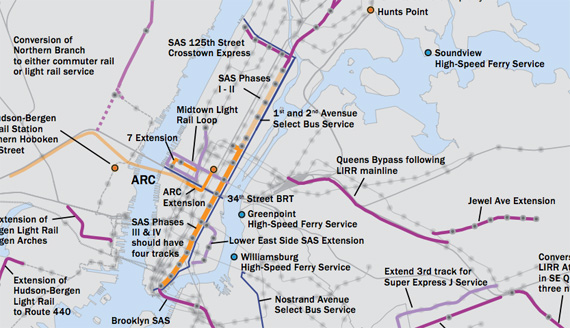In New Report, RPA Reinforces Link Between Transit and Growth

Following yesterday’s Build for America launch and last night’s presidential debate, the Regional Plan Association released a major report today recommending an array of public transportation improvements for New York City and northern New Jersey, adding its name to the ever-growing list of orgs and officials calling for federal investment to spur and sustain economic growth in the coming decades.
Over a dense 53 pages, "Tomorrow’s Transit: New Mobility for the Region’s Urban Core" [PDF] lays out dozens of projects, large and small, that would improve transit access and performance, with a focus on underserved and, in many cases, high poverty areas. The report, as breathtaking in scope as the $29 billion five-year capital plan unveiled by MTA head Lee Sander last March, also proposes augmentations to long-planned mega-projects like the Second Avenue Subway, and stresses links between modes to maximize coverage and efficiency.
Proposals are categorized by cost and level of need, as determined by existing transit service, income levels, and rates of auto ownership.
Follow the jump for highlights.
- Bronx: Extend the Second Avenue Subway to the Third Avenue corridor and Co-op City; provide added service on Metro-North at six Bronx station stops on the Harlem and Hudson River lines; offer peak express service on the Dyre Avenue line; and establish ferry service from Soundview.
- Brooklyn: Convert the Atlantic Branch of the LIRR to subway service and connect it to the Second Avenue Subway; build a Utica Avenue branch off the converted Atlantic Branch of the LIRR; extend the Nostrand Avenue 2 and 5 lines to Kings Highway; extend the Canarsie L line to Spring Creek Towers/Starrett City; and establish high speed ferry service from Williamsburg, Greenpoint, and Bay Ridge.
- Manhattan: Implement no-fare rides on the 34th Street, 42nd Street and 50th Street cross-town bus routes; extend the Second Avenue Subway west along 125th Street; construct a station entrance on the east end of the First Avenue L station; and establish a midtown Bus Rapid Transit or light rail route loop.
- Queens: Convert the LIRR Atlantic Branch to subway service; connect Queensboro Plaza and Queens Plaza and the E, F, G and V at Court Square; and begin Bus Rapid Transit on Queens Boulevard.
- Staten Island: Proceed with Hylan Boulevard Bus Rapid Transit; establish ferry service from southern Staten Island; and establish a bus lane along the full length of the Staten Island Expressway.
- New Jersey (Hudson County and Newark): Extend currently planned Bus Rapid Transit routes in Newark to include cross-town and Sumner/Mt. Prospect Avenue corridors; construct a new Hudson Bergen Light Rail Station at Grand Street and 17th Street in Hoboken; and extend the Hudson Bergen Light Rail to Route 440.
In addition, the RPA recommends a number of complementary measures, including parking and land use reforms, transit-oriented development, and congestion pricing.
"Tomorrow’s Transit" was composed over the course of a year in conjunction with area transportation experts, NJ TRANSIT, the MTA and New York City DOT.





